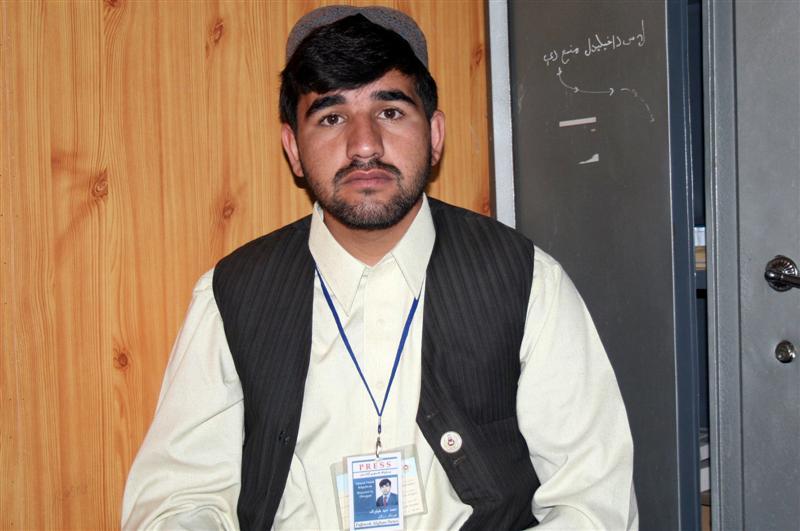Journalists, both local and foreign, not only face hostile enemy threats but occasionally become target of the protectors themselves, as in the case of Omaid Khpulwak, the young Afghan reporter killed by a US soldier in Uruzgan, a central province of Afghanistan.
The Afghanistan Analysts Network (AAN), an independent policy research
organisation, in its latest report “Death of an Uruzgan Journalist: Command Errors and Collateral Damage” unfurled the negligence on the part of NATO-led forces, which led to Omaid’s tragic death.
“It also raises the question of whether local journalists, who are the key figures in reporting in conflict zones in Afghanistan, can be better protected,” said Karen Clark, the author of the latest elaborate report on Omaid’s killing.
Her report raised a litany of questions – manner of handling similar episodes, such as Omaid’s in the future, ways to mitigate civilian causalities, protection of local journalists covering conflicts and proper dissemination of information before and after a tragedy.
Clark’s report also explores another crucial issue – even though the killing of Omaid was likely a lawful act of war, it bears important lessons about how the military can prevent what it calls ‘collateral damage’.
“A failure to establish whether civilians were trapped inside the RTA (Radio Television Afghanistan) building before launching the counter-attack and a failure to exercise ‘tactical patience’.
“Decisions made about how to deal with the Taleban suicide bombers, in the end worsened an already volatile situation and created the context in which Omaid was shot dead and seven US soldiers were injuredby the Taleban suicide bombers,” revealed Clark’s report.
Omaid, who had worked for BBC, Pajhowk Afghan News and RTA, was killed in his office, the RTA building in Tirin Kot, Uruzgan, on 28 July 2011, when it came under Taliban suicide attack and coalition forces counter-attack.
The report blames the NATO-led International Security Assistance Force (ISAF) for failing to protect civilians during shoot-outs and also criticised the pathetic manner of covering up the gross mistake, as in Omaid’s death.
“The military investigation also revealed the dismal, virtually negligible, role of Afghan security forces at RTA that day.
“Yet the press release from ISAF public affairs, published the day after the attack, gave a glutinously adulatory account of their actions. ISAF spokesmen have continued to try to spin the story, claiming even recently that the counter-attack had been ‘Afghan-led’, when in fact no Afghans were involved at all,” pointed out Clark, herself a veteran journalist who had covered Afghanistan.
During the early weeks, the Afghan government insisted that the Taliban had killed Omaid and his family received death threats in anonymous phone calls, they were told to stop voicing their suspicions that a US soldier had killed Omaid.
“They risked a great deal to give interviews and pass on ballistics and other evidence. ISAF’s failure to talk frankly with the media and Afghan population, caused needless distress to Omaid’s family and friends and helped spark suspicions of a cover up,” she added.
The AAN report acknowledged efforts made by General Allen, the Commander of NATO forces, to reduce civilian casualties by soldiers under his command (both ISAF and the predominantly US Special Operations Forces of Operation Enduring Freedom), but says this must be allied to honesty when operations go wrong.
“It’s unfortunate the military were forced to release this investigation because it shows that an honest explanation of events can be positive – its release has contributed to accountability for civilian deaths and improving the protection of civilians,’ added Clark.
Meanwhile, NATO in a response on Wednesday defended its reporting on the unfortunate incident.
In a statement, NATO spokesperson Lt. Col. Jimmie E. Cummings JR, said the final report had been placed in the Central Command (CENTCOM) Reading Room website since December 28, 2011.
Following the incident in July, ISAF was in communication with the family as well as BBC and they were also the first to be briefed, along with Pajhwok, on the findings of the report by ISAF on 8th September 2011.
After a thorough investigation it was determined that Omaid was killed in a case of mistaken identity. The reporter was shot by a US member who believed he was an insurgent that posed a threat and was about to detonate a suicide vest improvised explosive device (IED).
After thoroughly looking at all the evidence it was determined that US forces acted appropriately and within the ROE (Rules of Engagement) under the circumstances, he added.
vp
Visits: 2









GET IN TOUCH
NEWSLETTER
SUGGEST A STORY
PAJHWOK MOBILE APP